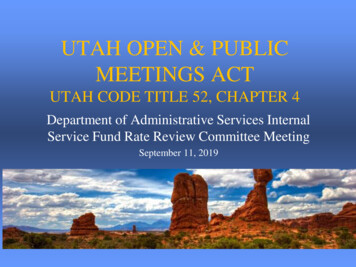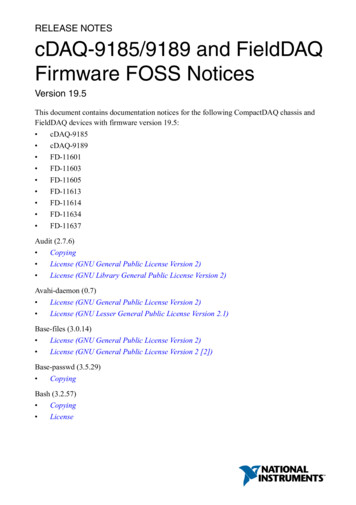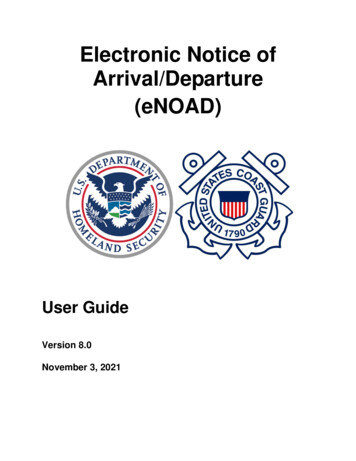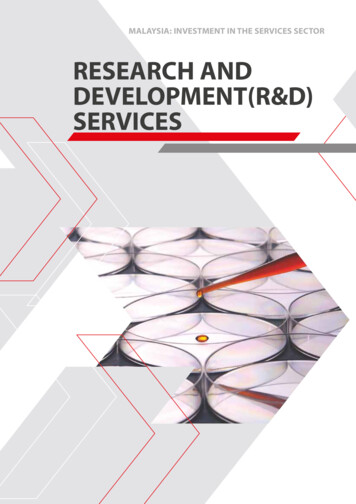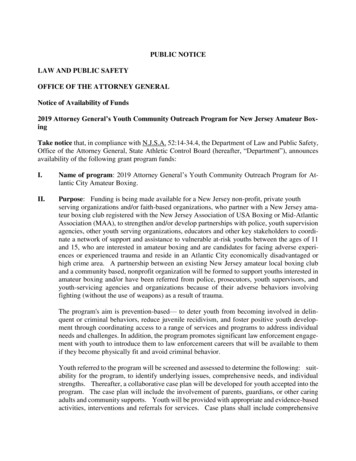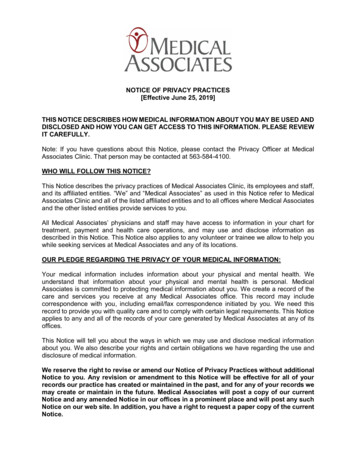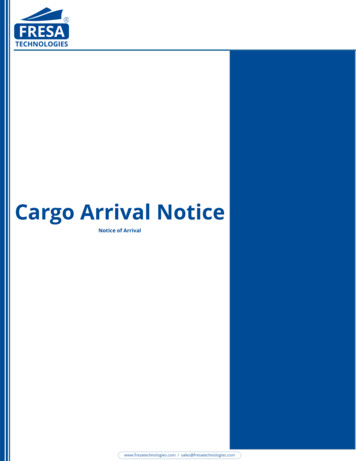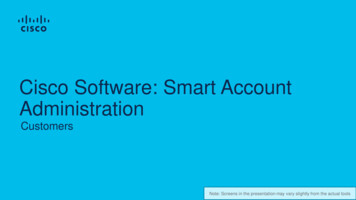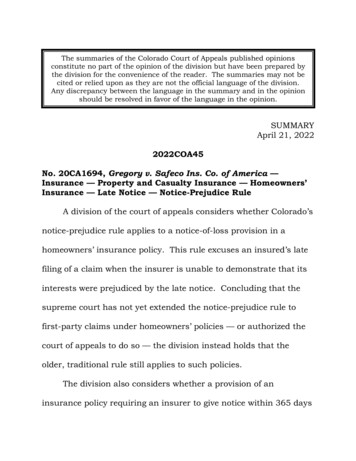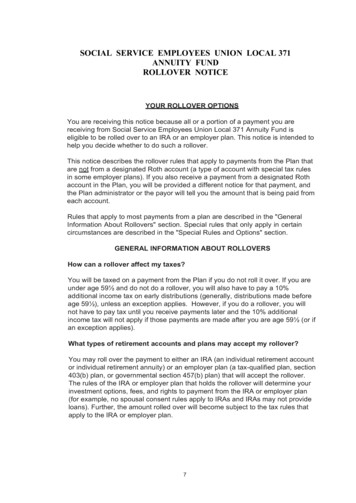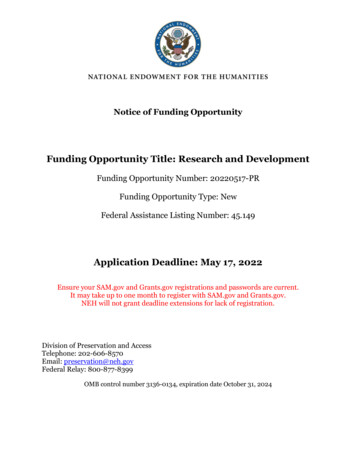
Transcription
Notice of Funding OpportunityFunding Opportunity Title: Research and DevelopmentFunding Opportunity Number: 20220517-PRFunding Opportunity Type: NewFederal Assistance Listing Number: 45.149Application Deadline: May 17, 2022Ensure your SAM.gov and Grants.gov registrations and passwords are current.It may take up to one month to register with SAM.gov and Grants.gov.NEH will not grant deadline extensions for lack of registration.Division of Preservation and AccessTelephone: 202-606-8570Email: preservation@neh.govFederal Relay: 800-877-8399OMB control number 3136-0134, expiration date October 31, 2024
Executive SummaryThe National Endowment for the Humanities (NEH) Division of Preservation and Access isaccepting applications for the Research and Development program. The purpose of this programis to support projects that address major challenges in preserving or providing access tohumanities collections and resources. Research and Development offers two funding tiers inorder to address projects at all stages of development and implementation.Funding Opportunity TitleFunding Opportunity NumberFederal Assistance Listing NumberOptional Draft DeadlineApplication DeadlineAnticipated AnnouncementsAnticipated FY 2023 FundingEstimated Number and Type of AwardsAward AmountsCost Sharing/Match RequiredPeriod of PerformanceEligible ApplicantsProgram Resource PagePre-Application WebinarPublished20220517-PRResearch and Development20220517-PR45.149April 12, 2022, 11:59 p.m. Eastern TimeMay 17, 2022, 11:59 p.m. Eastern TimeDecember 2022Approximately 1,500,000Approximately 7-8 grantsTier I: up to 75,000Tier II: up to 350,000NoTier I: up to two yearsTier II: up to three yearsProjects must start between March 1, 2023, andSeptember 1, 2023.Eligible applicants include U.S. nonprofitorganizations with 501(c)(3) tax-exempt status,accredited public and 501 (c)(3) institutions ofhigher education, state and local governmentalagencies, and federally recognized Native Americantribal governments.See C. Eligibility Information for reservation/researchand-developmentA pre-recorded webinar will be posted here by 5:00p.m. Eastern Time on March 4, 2022.February 17, 2022i
Table of ContentsA. Program Description . 11. Purpose . 12. Background .3B. Federal Award Information . 41. Type of Application and Award . 42. Summary of Funding . 4C. Eligibility Information . 51. Eligible Applicants. 52. Cost Sharing . 53. Other Eligibility Information . 6D. Application and Submission Information . 71. Application Package . 72. Content and Form of Application Submission . 73. Unique Entity Identifier and System for Award Management .254. Submission Dates and Times . 265. Intergovernmental Review. 276. Funding Restrictions . 27E. Application Review Information . 281. Review Criteria . 282. Review and Selection Process . 283. Assessment of Risk and Other Pre-Award Activities . 294. Anticipated Announcement and Award Dates . 29F. Federal Award Administration Information . 291. Federal Award Notices . 292. Administrative and National Policy Requirements . 293. Reporting . 31G. Agency Contacts. 32H. Other Information. 3320220517-PRii
A. Program Description1. PurposeThe Research and Development program supports projects that address major challenges inpreserving or providing access to humanities collections and resources. These challenges includethe need to find better ways to preserve materials of critical importance to the nation’s culturalheritage—from fragile artifacts and manuscripts to analog recordings and digital assets subjectto technological obsolescence—and to develop advanced modes of organizing, searching,discovering, and using such materials.This program supports projects at all stages of development, from early planning andstandalone studies to advanced implementation. Research and Development projects contributeto the evolving and expanding body of knowledge for heritage practitioners, and for that reason,outcomes may take many forms. Projects may produce any combination of laboratory datasets,guidelines for standards, open access software tools, workflow and equipment specifications,widely used metadata schema, publications, online resources, or other products.Research and Development supports work on the entire range of humanities collection typesincluding, but not limited to, moving image and sound recordings, archaeological artifacts,born-digital and time-based media, rare books and manuscripts, archival records, materialculture, and art. Applicants must demonstrate how advances in preservation and access througha Research and Development project would benefit the cultural heritage community bysupporting humanities research, teaching, or public programming.Research and Development projects are encouraged to address one or more of the followingareas of special interest: Preserving audiovisual and digital heritage. Research and Development supportswork to address the needs of collection formats most at risk of obsolescence. Projectsmay address issues such as format degradation, preservation work at scale, algorithmicand machine learning methodologies, storage, sustainable infrastructure, data appraisal,and curation.Conserving the material past. Research and Development supports scientific workto improve the conservation treatment and preventive care of cultural heritage.Protecting imperiled cultural heritage. Research and Development supports thedevelopment of tools, methods, technologies, or workflows for documenting, sharing,visualizing, and presenting lost or imperiled cultural heritage materials. Learn moreabout Protecting our Cultural Heritage.Serving under-represented communities. Research and Development supportswork that would enhance the preservation of and access to humanities collections forunder-represented communities, including minority communities, Indigenouscommunities, and persons with disabilities.Responding to climate change. Research and Development supports workinvestigating the impacts of climate change on heritage collections along with developingresponses to advance sustainability and resilience.Given the complexities of preserving and providing access to humanities collections, thisprogram recognizes the importance of forming interdisciplinary teams by bringing togetherparticipants with expertise in the humanities, preservation, information and computer science,20220517-PR1
and natural science. The exact mix of specialists will depend on the nature of your project. Yourteam should embody a well-defined humanities perspective that can frame your objectives andguide the project to successful completion. Such a perspective may be provided by members ofan advisory committee, a consultant, a project co-director, or another member of the projectteam.Recipients should communicate the results of their work to appropriate scholarly and publicaudiences. Recipients must also submit a white paper documenting lessons learned in thecourse of their projects, so that others can benefit from their experiences. White papers will beposted on the NEH website. See E1. Reporting Requirements.See D6. Funding Restrictions for unallowable activities.See E1. Review Criteria for review criteria.Funding categoriesThe Research and Development program offers two funding tiers in order to address projects atall stages of development and implementation.Tier I: Planning, Basic Research, or ModificationsTier I provides awards up to 75,000 for a period of performance of up to two years. This tiersupports the following activities: Planning and preliminary work for large-scale research and development projects.Proposals must identify one or more project deliverable, such as the creation of an actionagenda, work plan, published report, draft standard, or software prototype, that preparesthe project team for subsequent stages of work.Discrete research projects such as case studies or laboratory experiments. Such projectsdo not need to involve planning or preliminary research for a larger project.Nevertheless, they must address research issues or problems in the cultural heritagefield.Modifications or updates to established or emerging standards, methodologies, tools andequipment, or workflows.Tier II: Advanced ImplementationTier II provides awards up to 350,000 for a period of performance of up to three years. Thislevel supports the following activities: Development of standards, practices, methodologies, or workflows for preserving andcreating access to humanities collections.Applied research addressing preservation and access issues concerning humanitiescollections.Topic or area study in heritage preservation and access conducted using convenings,surveys, collaborative research, and other qualitative and quantitative modes ofinvestigation. Possible deliverables could include publications, online resources,guidelines, and agenda for collective action. Applicants are encouraged to involve multiinstitutional and community stakeholders working to achieve substantial national orinternational impact.20220517-PR2
Tier II applicants must demonstrate project planning and preliminary research. Support for thatplanning might have come from NEH, from other federal or foundation awards, or from aninstitution’s own funds.Successful completion of a Tier I project is not a prerequisite for applying for a Tier II award.2. BackgroundThis program is authorized by 20 U.S.C. § 956. Awards are subject to 2 CFR Part 200 UniformAdministrative Requirements, Cost Principles, and Audit Requirements for Federal Awards, andthe General Terms and Conditions for Awards to Organizations (for grants and cooperativeagreements issued January 1, 2022 or later).According to the National Foundation on the Arts and the Humanities Act of 1965, “The term‘humanities’ includes, but is not limited to, the study of the following: language, both modernand classical; linguistics; literature; history; jurisprudence; philosophy; archaeology;comparative religion; ethics; the history, criticism and theory of the arts; those aspects of thesocial sciences which have humanistic content and employ humanistic methods; and the studyand application of the humanities to the human environment with particular attention toreflecting our diverse heritage, traditions, and history and to the relevance of the humanities tothe current conditions of national life.”Use the Funded Projects Query Form to find examples of NEH-supported projects.Learn more about NEH.NEH InitiativesNEH seeks to support projects that respond to the following initiatives. NEH will give allapplications equal consideration in accordance with the program’s review criteria.In addition to the special initiatives listed below, NEH encourages projects that include NativeAmerican organizations and communities as lead applicants and project partners.A More Perfect Union: Exploring America's Story and Commemorating its250th AnniversaryThe task of building a more perfect Union rooted in the ideal of human equality falls to everygeneration of Americans, ours no less than our predecessors. The basic goals of life, liberty, andthe pursuit of happiness endure over time, even as the challenges change: from founding anation out of colonies; to dismantling the institution of slavery; to prevailing through times ofeconomic depression and war; to advancing civil rights for all; to strengthening our democraticinstitutions; to building a more inclusive and sustainable society.NEH’s A More Perfect Union initiative encourages projects that explore, reflect on, and tell thestories of our quest for a more just, inclusive, and sustainable society throughout our history.NEH especially welcomes projects that bring the perspective of the humanities to questions ofracial justice, gender equality, the evolution of the American landscape, as well as America’splace in the world. Projects that strengthen Americans’ knowledge of our principles ofconstitutional governance and democracy are strongly encouraged, as are projects that addressthe experiences of Native Americans and other under-represented communities. In addition,NEH welcomes projects that develop innovative approaches to sustaining the nation’shumanities infrastructure and preserving its historical record.20220517-PR3
Protecting our Cultural HeritageIn response to the destruction of cultural heritage materials worldwide, NEH encouragesapplications for projects that study, document, or create digital representations of lost orimperiled cultural heritage materials. Proposed projects should be based on scholarly work andfollow standards and best practices. Projects must demonstrate the capacity to be sustained andmust be widely accessible to the public. Learn more about Protecting our Cultural Heritage.B. Federal Award Information1. Type of Application and AwardNEH seeks new applications in response to this notice.NEH will provide funding in the form of grants.2. Summary of FundingAward AmountsYou may request up to 75,000 for Tier I awards or 350,000 for Tier II awards.NEH anticipates approximately 1,500,000 to fund an estimated seven to eight recipients.NEH will not determine the amount available until Congress enacts the final FY 2023 budget.This notice is subject to the availability of appropriated funds and is a contingency action takento ensure that, should funds become available for this purpose, applications can be processedand funds awarded in a timely manner.Period of PerformanceYou may request a period of performance of up to two years for Tier I awards and up to threeyears for Tier II awards. The period of performance must start between March 1, 2023, andSeptember 1, 2023. The period of performance must start on the first day of the month.C. Eligibility Information1. Eligible ApplicantsEligible applicants must be based in the United States or its jurisdictions and be one of thefollowing: a nonprofit organization with 501(c)(3) tax-exempt statusan accredited institution of higher education (public or 501(c)(3))a unit of state or local governmenta federally recognized Native American tribal governmentAn eligible applicant may apply on behalf of a consortium of collaborating organizations. Ifselected for funding, the applicant will be programmatically, legally, and fiscally responsible forthe award.20220517-PR4
Eligible applicants acting as solely fiscal agents or fiscal sponsors may not apply on behalf ofineligible applicants.Individuals and other organizations, including foreign and for-profit entities, are ineligible.2. Cost SharingCost sharing is not required in this program unless you request federal matching funds.Cost sharing or matching is the portion of the project costs not paid by NEH funds. Cost sharingwill not be considered in the evaluation of applications.Required cost sharing includes third-party non-federal gift money that must be raised to releasefederal matching funds. Applicants requesting federal matching funds must raise dollar-fordollar cash contributions from nonfederal third parties and have them certified by NEH beforethe funds are released (see the NEH Federal Matching Funds Guidelines). Federal matchingfunds are typically distributed on an annual basis over the life of the award.Applicants may contribute voluntary cost share to projects in which the total costs exceed theamount awarded by NEH. Voluntary cost share includes: cash contributions made to the project by the applicantunrecovered indirect coststhird party cash contributions made to the projectthird-party in-kind contributions (non-cash contributions, such as property or services,that benefit the project and are contributed by non-federal third parties, without charge,to the recipient)Recipients must maintain auditable records of the source and use of contributed cost share. See2 CFR § 200.306.Learn about types of funding offered by NEH.3. Other Eligibility InformationEligible applicants may submit multiple applications for separate and distinct projects underthis notice.Applicants may revise and resubmit previously rejected applications, which NEH will assess bythe same criteria as others in the current competition.Prior NEH award recipients may request support for a new or subsequent stage of the sameproject. NEH will assess such proposals by the same criteria as others in the currentcompetition.Per 2 CFR § 200.403(f), overlapping project costs across multiple applications for federalfunding and/or approved federal award budgets are not allowed. However, applicants may seekfunding for complementary aspects of the same overall project. NEH may disallow costs orreject applications with overlapping project costs. An individual’s level of effort cannot exceed100% across all active federally funded awards.20220517-PR5
NEH does not make awards to other federal entities or to applicants whose projects are soclosely intertwined with a federal entity that the project takes on characteristics of the federalentity’s own authorized activities. Applicants may use funds from, or sites and materialscontrolled by, other federal entities. Such resources may not be used as gifts to release NEHmatching funds.NEH does not provide financial assistance to foreign institutions or organizations. Nevertheless,otherwise eligible American institutions may apply for collaborative projects involving U.S. andforeign organizations provided they do not use NEH funds for the purpose of issuing subawardsto any foreign organization, as defined in 2 CFR §§ 200.1 and .331(a). Eligible applicants mayhire foreign individuals and consultants to carry out various programmatic activities on a feefor-service basis, as specified in 2 CFR § 200.459 and secure vendor contracts such as incountry transportation services. If you are interested in submitting an application for a projectinvolving international collaboration, consult with program staff.Except for the rare cases covered by NEH’s late submission policy, applicationsmust be received by the deadline. Incomplete, nonresponsive, or ineligibleapplications will not be considered for funding under this notice. Applicationsmust adhere to specified page limits and formatting requirements or they will notbe reviewed. See the Application Components Table.D. Application and Submission Information1. Application PackageYou must apply using Grants.gov Workspace or a Grants.gov system-to-system solution. Youcan find this funding opportunity in Grants.gov under number 20220517-PR. There is also a linkon the program resource page.You can find the application package, which includes a series of required and conditionallyrequired forms, for this funding opportunity under the “Package” tab. You will upload additionalapplication components into the Attachments Form.You must complete a multistep registration process to submit your application. See D3. UniqueEntity Identifier and System for Award Management.Contact preservation@neh.gov to request a paper copy of this notice.If you are deaf or hard of hearing, you can contact NEH using Federal Relay at 800-877-8399.2. Content and Form of Application SubmissionYour application will include a narrative, budget, and other forms and attachments. You willcomplete the forms within Grants.gov Workspace and upload other components into theAttachments Form. See the Application Component Table.NEH has assigned each application components one of the following designations: Required: All applicants must submit this component.Conditionally Required: Applicants must submit this component if they meet thespecified conditions.20220517-PR6
Recommended: NEH encourages, but does not require, applicants to submit thiscomponent.You must submit all required and relevant conditionally required components. Applicationsmissing any required or relevant conditionally required components will beconsidered incomplete and rejected from further consideration.In addition, NEH has established page limits for some application components: Mandatory: Applicants must not exceed the page limit.Suggested: NEH encourages, but does not require, applicants to abide by the page limit.You must abide by the page limits and formatting instructions in this notice. Applicationsthat exceed page limits or violate formatting instructions will be considerednonresponsive and rejected from further consideration.Your application components must conform to the following formatting requirements, unlessotherwise indicated: paper no larger than standard letter (8 ½" x 11”)at least one-inch margins on all sides for all pagesa font no smaller than 11-pointIn addition, you are encouraged to format your components consistent with the following: single-spacinga readable font such as Arial, Georgia, Helvetica, or Times New Romanany standard citation style (citations are included in page counts)20220517-PR7
Application Components TableApplication ComponentFile NameGrants.gov formsSF-424 Application for FederalAssistance - Short OrganizationalSupplementary Cover Sheet forNEH Grant ProgramsProject/Performance Site(s)Location FormResearch and Related BudgetAttachments FormCertification Regarding LobbyingDesignationPage itionallyrequiredConditionallyrequiredStandard Form-LLL “Disclosureof Lobbying Activities”Attachments1: Narrativenarrative.pdfRequired2: List of project personnel3: Résumés for key : Bibliography andenvironmental scan5: Work plan6: History of support7: Letters of commitment8: Letters of support9: Federally negotiated indirectcost rate agreement10: Explanation of delinquentfederal debt11: Additional allyrequireddelinquentdebt.pdf Conditionallyrequireddocumentation.pdf RecommendedTier I: 10Tier II: 15(mandatory)2 pages dfsupport.pdfagreement.pdf50 pages(mandatory)NarrativeCompose a narrative that provides a comprehensive description of your proposed project. Yournarrative should be succinct, well organized, and free of technical terms and jargon so that peerreviewers can understand the proposed project.You must limit the narrative to ten (Tier I) or fifteen (Tier II) single-spaced pageswith one-inch margins and a font size of at least eleven point. Do not include anexecutive summary or a table of contents. You may include images, charts, diagrams, footnotes,and endnotes if they fit within the page limit.20220517-PR8
Organize your narrative using the following section headings. Each section aligns withcorresponding review criteria.1. Significance to the humanities (aligns with review criterion 1)Explain the preservation and access research challenge to be addressed and how the culturalheritage field would benefit from the proposed solution. Consider which types of humanitiescollections or resources, as well as institutions, would benefit from improvements topreservation and access practices. Clearly identify the project outcomes and describe how theywould support enhancements to conducting humanities research, education, or publicprogramming. If applicable, indicate how project results might serve the humanities needs ofunder-represented communities.2. Preservation and access research impact (aligns with review criterion 1)Describe how your project relates to other work in the preservation field and how your proposedoutcomes would contribute to advancing specific theories, practices, or overall knowledge abouta particular topic or issue. Explain plans to disseminate project results and their anticipatedadoption or integration by practitioners. If you are requesting funding for extensive audienceengagement to ensure adoption, you may include a detailed dissemination plan in Attachment10: Additional supporting documentation. You may provide a bibliography and environmentalscan in Attachment 4: Bibliography and environmental scan.3. Project history, scope, and duration (aligns with review criteria 1 and 3)Provide a concise history of the project, including information about previous research orplanning. Indicate what has been accomplished in previous phases and the degree to which theproject has met its established goals. You may list any publications, in print or electronic form,that have already been produced in Attachment 4: Bibliography and environmental scan. Foronline projects, include the website and metrics that would demonstrate the project’ssignificance to its field.If you are requesting funding for a component of a larger project that will not be completed in itsentirety during the requested period of performance, describe the scope and duration of theentire project and distinguish how accomplishments or products intended for this phase wouldcontribute to the overall effort.4. Methodology (aligns with review criterion 2 and 3)Discuss the procedures and standards that will be followed in carrying out the project,considering the following: Developmental or experimental methodology: Discuss the methodologicalapproach that you will employ to accomplish objectives. Indicate any programminglanguages, platforms, software, or other applications you will employ to assist you withexecuting this methodology.Collections handling: For projects working directly with a humanities collection as atest bed, discuss efforts to ensure proper handling and, if applicable, preservation.Data capture: Describe which instruments and tools will be used to capture or generatedata and efforts to ensure data integrity.Intellectual property and privacy: Discuss the management of intellectual propertyor privacy permissions necessary to ensure the availability of the project’s results—forexample, proprietary technologies or licensed software. You should already haveobtained permissions in matters concerning intellectual property, and you should20220517-PR9
provide pertinent documentation in Attachment 10: Additional supportingdocumentation.5. Work plan (aligns with review criteria 2, 3, and 6)Summarize your work plan, including a high-level schedule indicating what you will accomplishduring each stage of the project. Provide a detailed version of your work plan in Attachment 5:Work plan.6. Institutional profile and project staff (aligns with review criteria 4 and 6)Explain the applicant institution’s capabilities for conducting the project, including itspossession of the necessary technical infrastructure and scientific facilities. Describe theinstitution’s experience in areas related to the project. Discuss the capabilities of anycollaborating institutions or organizations including institutions representing minority andIndigenous communities.Discuss the disciplinary and professional makeup of the project team as it pertains to objectivesand proposed activities.Describe the staff members’ duties and qualifications. Indicate the amount of time that theprincipal members of the project team will devote to the project.If the project has an advisory board, explain the board’s function and identify theresponsibilities of key members. Provide the names and affiliations of all project personnel,advisory board members, and consultants in Attachment 2: List of project personnel.Explain how community perspectives and representation would be incorporated in the proposedactivities and decision-making process. In the case of Nativ
a Research and Development project would benefit the cultural heritage community by supporting humanities research, teaching, or public programming. Research and Development projects are encouraged to address one or more of the following areas of special interest: Preserving audiovisual and digital heritage. Research and Development supports
